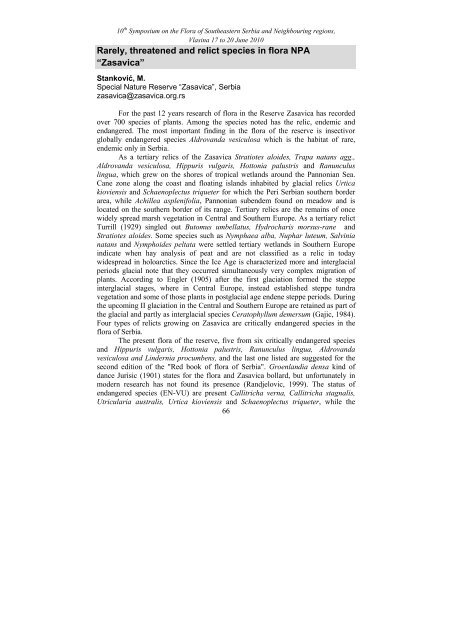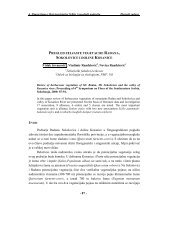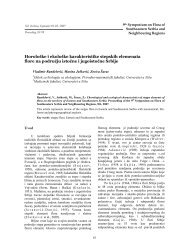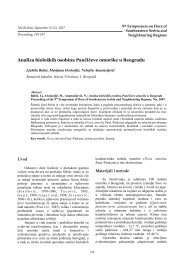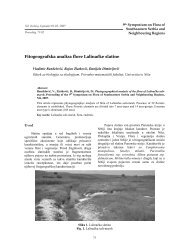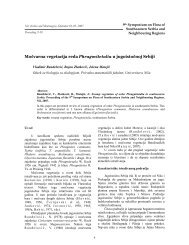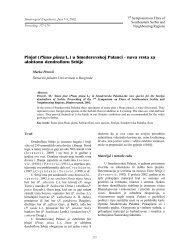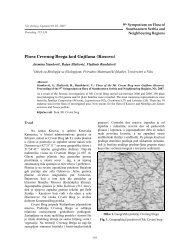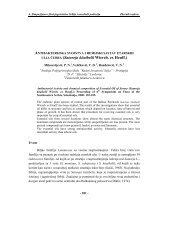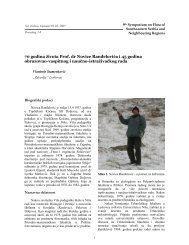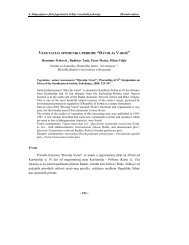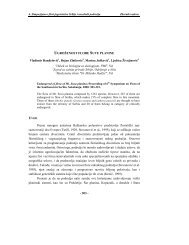10th Symposium on the Flora of Southeastern Serbia and ...
10th Symposium on the Flora of Southeastern Serbia and ...
10th Symposium on the Flora of Southeastern Serbia and ...
You also want an ePaper? Increase the reach of your titles
YUMPU automatically turns print PDFs into web optimized ePapers that Google loves.
10 th <str<strong>on</strong>g>Symposium</str<strong>on</strong>g> <strong>on</strong> <strong>the</strong> <strong>Flora</strong> <strong>of</strong> Sou<strong>the</strong>astern <strong>Serbia</strong> <strong>and</strong> Neighbouring regi<strong>on</strong>s,Vlasina 17 to 20 June 2010Rarely, threatened <strong>and</strong> relict species in flora NPA“Zasavica”Stanković, M.Special Nature Reserve “Zasavica”, <strong>Serbia</strong>zasavica@zasavica.org.rsFor <strong>the</strong> past 12 years research <strong>of</strong> flora in <strong>the</strong> Reserve Zasavica has recordedover 700 species <strong>of</strong> plants. Am<strong>on</strong>g <strong>the</strong> species noted has <strong>the</strong> relic, endemic <strong>and</strong>endangered. The most important finding in <strong>the</strong> flora <strong>of</strong> <strong>the</strong> reserve is insectivorglobally endangered species Aldrov<strong>and</strong>a vesiculosa which is <strong>the</strong> habitat <strong>of</strong> rare,endemic <strong>on</strong>ly in <strong>Serbia</strong>.As a tertiary relics <strong>of</strong> <strong>the</strong> Zasavica Stratiotes aloides, Trapa natans agg.,Aldrov<strong>and</strong>a vesiculosa, Hippuris vulgaris, Hott<strong>on</strong>ia palustris <strong>and</strong> Ranunculuslingua, which grew <strong>on</strong> <strong>the</strong> shores <strong>of</strong> tropical wetl<strong>and</strong>s around <strong>the</strong> Pann<strong>on</strong>ian Sea.Cane z<strong>on</strong>e al<strong>on</strong>g <strong>the</strong> coast <strong>and</strong> floating isl<strong>and</strong>s inhabited by glacial relics Urticakioviensis <strong>and</strong> Schaenoplectus triqueter for which <strong>the</strong> Peri <strong>Serbia</strong>n sou<strong>the</strong>rn borderarea, while Achillea asplenifolia, Pann<strong>on</strong>ian subendem found <strong>on</strong> meadow <strong>and</strong> islocated <strong>on</strong> <strong>the</strong> sou<strong>the</strong>rn border <strong>of</strong> its range. Tertiary relics are <strong>the</strong> remains <strong>of</strong> <strong>on</strong>cewidely spread marsh vegetati<strong>on</strong> in Central <strong>and</strong> Sou<strong>the</strong>rn Europe. As a tertiary relictTurrill (1929) singled out Butomus umbellatus, Hydrocharis morsus-rane <strong>and</strong>Stratiotes aloides. Some species such as Nymphaea alba, Nuphar luteum, Salvinianatans <strong>and</strong> Nymphoides peltata were settled tertiary wetl<strong>and</strong>s in Sou<strong>the</strong>rn Europeindicate when hay analysis <strong>of</strong> peat <strong>and</strong> are not classified as a relic in todaywidespread in holoarctics. Since <strong>the</strong> Ice Age is characterized more <strong>and</strong> interglacialperiods glacial note that <strong>the</strong>y occurred simultaneously very complex migrati<strong>on</strong> <strong>of</strong>plants. According to Engler (1905) after <strong>the</strong> first glaciati<strong>on</strong> formed <strong>the</strong> steppeinterglacial stages, where in Central Europe, instead established steppe tundravegetati<strong>on</strong> <strong>and</strong> some <strong>of</strong> those plants in postglacial age endene steppe periods. During<strong>the</strong> upcoming II glaciati<strong>on</strong> in <strong>the</strong> Central <strong>and</strong> Sou<strong>the</strong>rn Europe are retained as part <strong>of</strong><strong>the</strong> glacial <strong>and</strong> partly as interglacial species Ceratophyllum demersum (Gajic, 1984).Four types <strong>of</strong> relicts growing <strong>on</strong> Zasavica are critically endangered species in <strong>the</strong>flora <strong>of</strong> <strong>Serbia</strong>.The present flora <strong>of</strong> <strong>the</strong> reserve, five from six critically endangered species<strong>and</strong> Hippuris vulgaris, Hott<strong>on</strong>ia palustris, Ranunculus lingua, Aldrov<strong>and</strong>avesiculosa <strong>and</strong> Lindernia procumbens, <strong>and</strong> <strong>the</strong> last <strong>on</strong>e listed are suggested for <strong>the</strong>sec<strong>on</strong>d editi<strong>on</strong> <strong>of</strong> <strong>the</strong> "Red book <strong>of</strong> flora <strong>of</strong> <strong>Serbia</strong>". Groenl<strong>and</strong>ia densa kind <strong>of</strong>dance Jurisic (1901) states for <strong>the</strong> flora <strong>and</strong> Zasavica bollard, but unfortunately inmodern research has not found its presence (R<strong>and</strong>jelovic, 1999). The status <strong>of</strong>endangered species (EN-VU) are present Callitricha verna, Callitricha stagnalis,Utricularia australis, Urtica kioviensis <strong>and</strong> Schaenoplectus triqueter, while <strong>the</strong>66


